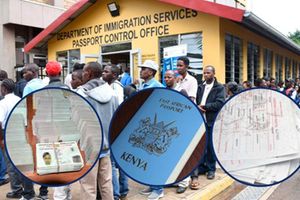Rules on school re-admission of young mums normalises teen pregnancy

A young mother at Komesi Resource Centre in West Pokot County, a home for escapees of FGM and early marriages on December 08, 2020.
What you need to know:
- Teenage pregnancy is just not a national problem but a regional one too.
- Step eight allows a learner who “becomes pregnant more than once” to be readmitted as long as she is “within the mandatory schooling age". ButBut it does not state how such repeated pregnancies should be prevented, hence appears permissive.
- The most debatable provision is Step 10, which requires the learner to “disclose the identity of the person responsible for the pregnancy” with a rider that if he is a “school boy or is under the age of 18”, he shall be guided about his “responsibilities”.
At the end of last year, the Ministry of Education issued re-entry guidelines to benefit learners who drop out of school due to pregnancy or other factors. Quite alarming in the document is a revelation from a 2016 study that “approximately 70 per cent of …girls aged 13- 19 in Homa Bay County reported having dropped out of school due to pregnancy”.
Teenage pregnancy is just not a national problem but a regional one too. A 2018 study shows that East Africa has the highest rate in the continent, at 21.5 per cent.
The ministry document contains 13 steps to handle pregnancy cases. The first four focus on communication with the girl and her parents or guardians. The next five deal with readmission protocols. The last four regard action on those responsible for the pregnancies. A number of the steps are debatable.
Health services
Step two requires that the pregnant learner be linked to a nearby facility for “access to age-appropriate reproductive health services”. This recognizes that such learners have special needs. But one wonders whether such “age-appropriate” services exist in public health facilities or if this is wishful thinking.
Step eight allows a learner who “becomes pregnant more than once” to be readmitted as long as she is “within the mandatory schooling age”. But it does not state how such repeated pregnancies should be prevented, hence appears permissive. Step nine states that learners aged 18 years and above “shall be advised to enrol in Adult and Continuing Education or vocational training centres”.
This assumes that children join Grade One aged seven and proceed uninterrupted to Form Four. But is this the reality? There are many parts of Kenya where children join school much later and are still there beyond 18. There are also adults who join secondary school even from the comfort of parenthood. Moreover, pushing the affected learners to vocational training centres excludes them from the secondary school curriculum.
Sexual partner
The most debatable provision is Step 10, which requires the learner to “disclose the identity of the person responsible for the pregnancy” with a rider that if he is a “school boy or is under the age of 18”, he shall be guided about his “responsibilities”. This assumes that the girl had one sexual partner and is willing to make his identity known. The guidelines are silent on what is to be done if she declines to name him and what happens if she had more partners and is unable to pinpoint the culpable one.
Guiding the boy about his “responsibilities” is based on the notion that since it took two to tango, it must take the same to raise the child. Whether such counselling actually translates into discharge of the responsibilities would be a study worth doing.
The guidelines also require that other adult perpetrators be reported for administrative and legal action. But they do not outline solutions if the allegation is contested. The guidelines also have nothing on learners aged 18 who become pregnant. By law, they have capacity to consent. But does age stop pregnancy from affecting their education?
Care for the infants
Evidence shows that implementation of such guidelines is constrained by social stigma and resistance from moralistic school administrators who consider such girls bad examples to schoolmates. As well, many affected girls cannot simply re-join school because there is no one willing or able to care for the infants while they attend school.
The guidelines do not provide options for them. There is also a conspicuous omission of the State Department for Gender and county women’s representatives from actors to collaborate in implementing the guidelines.
Most critical is that such reactive guidelines seem to be accepting defeat, hence normalizing schoolgirl pregnancy. Should we not instead invest more on preventing the problem? Is there anything we can learn from other countries?
European countries
North and South Korea, which have the lowest rates of teenage pregnancy globally, have tamed the phenomenon through zero tolerance and extreme social measures. European countries with low rates have used education about sexuality and open guidance by parents. A solution probably lies in between these two models.
For a start, we should look at the 2018 Teenage Pregnancy Prevention Framework of England on how the country has reduced under-18 conception by 62 per cent. The measures applied were; education on relationships and sex; youth-friendly sexual health services; targeting of young people at risk; support for parents to discuss sexual health; training for relevant professionals; access to contraception in non-health education and youth settings; consistent messages on the issue; support to prevent subsequent pregnancies; and strong use of data for monitoring.
The framework states that “improved use of effective contraception has the biggest impact on reducing teenage pregnancy”. Food for thought.
The writer is an international gender and development consultant and scholar.





